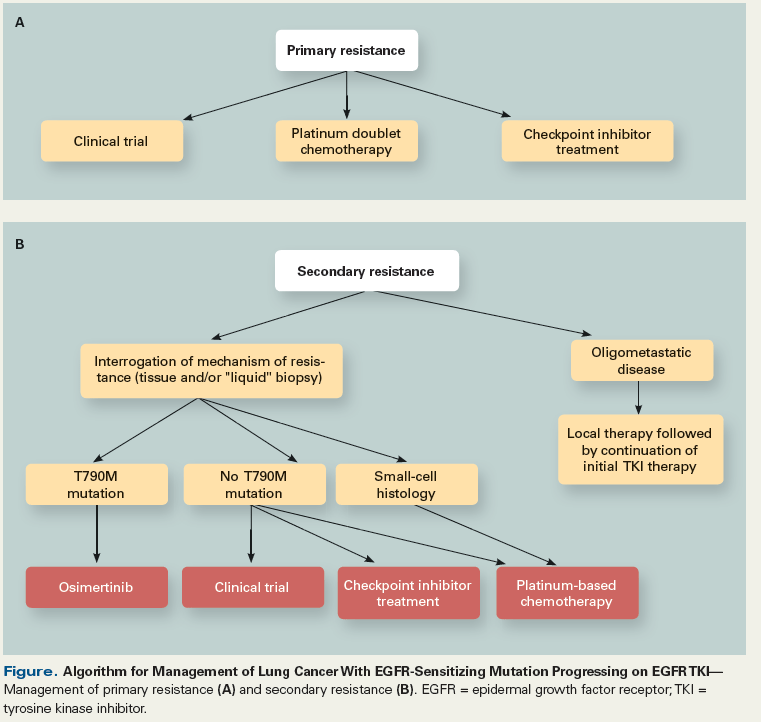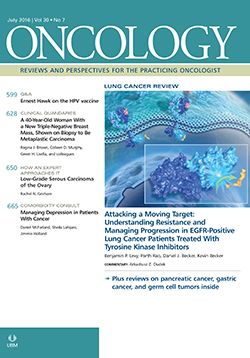Management of Resistance to EGFR TKI–Targeted Therapy of Lung Cancer: Lessons in Monitoring Cancer Evolution
Cancer cells undergo accelerated evolutionary changes; thus, under the pressure of novel generations of EGFR TKIs, we should expect to see new mechanisms of resistance.
Oncology (Williston Park). 30(7):616–618.

Figure. Algorithm for Management of Lung Cancer With EGFR-Sensitizing Mutation Progressing on EGFR TKI

Epidermal growth factor receptor tyrosine kinase inhibitors (EGFR TKIs) were initially developed with the rationale that they would inhibit the growth of tumors with EGFR overexpression.[1] Although the early clinical trials of these agents referred to “targeted” therapy, they included all patients with a diagnosis of non–small-cell lung cancer (NSCLC) progressing on front-line chemotherapy, without patient selection based on a proposed mechanism of action for the therapy under investigation. This all-inclusive strategy resulted in the induction of tumor responses in only 8.9% of lung cancer patients.[2] To find tumors that would more predictably respond to an EGFR TKI–directed treatment strategy, efforts were initiated to find appropriate biomarkers for responsiveness to EGFR TKI therapy; the first candidates were EGFR protein expression and EGFR amplification by fluorescence in situ hybridization.[3] However, EGFR TKI–sensitizing mutations were revealed only when investigators performed an analysis of tumors that were unusual responders to EGFR TKI therapy.[4] This led to the development of clinical trials targeting the subset of patients with EGFR TKI–sensitizing mutations,[5] the results of which confirmed superior response rates and improved progression-free survival (PFS) when TKIs were used in front-line treatment as compared with chemotherapy.
Soon after EGFR TKIs had begun to be used for treatment of tumors with EGFR TKI–sensitizing mutations, an emergence of acquired resistance was observed,[6] with a secondary mutation in exon 20 leading to substitution of methionine for threonine at position 790 (T790M); this point mutation interfered with the ability of first and second generations of EGFR TKIs to bind to the adenosine triphosphate pocket of the tyrosine kinase domain of EGFR. An effort to overcome this resistance led to the development of a third generation of EGFR TKIs, one of which (osimertinib) is currently commercially available.[7]
However, as Dr. Levy and colleagues describe in this issue of ONCOLOGY,[8] almost half of cases of resistance to EGFR TKIs result from adaptation of cancer cells other than those with T790M mutations to EGFR TKI pressure (see Figure 2 in the current review by Levy et al: Acquired Mutations of EGFR in NSCLC). Patients with primary and secondary resistance to EGFR TKIs whose tumors carry EGFR mutations other than T790M should be offered participation in clinical trials such as the NCI-MATCH study (ClinicalTrials.gov identifier: NCT02465060), which assigns patients to an inhibitor therapy targeting a specific genomic aberration; for example, patients whose tumors carry acquired BRAF mutation receive therapy with dabrafenib (a BRAF inhibitor), whereas patients whose tumors have PIK3CA mutation receive therapy with taselisib (an investigational phosphoinositide 3-kinase inhibitor).
Characterization of molecular mechanisms of resistance
Levy et al[8] bring up a critical point regarding the need for rebiopsy in order to understand a tumor’s mechanism of escape from EGFR TKI suppression. Citing a study by Chouaid et al,[9] they point out that rebiopsy in clinical practice is not frequently done for a number of reasons. The introduction of analysis of circulating cell-free DNA (cfDNA) originating from tumor, or “liquid biopsy,” can circumvent tumor rebiopsy challenges. There are several commercial tests available to perform genetic analysis of cfDNA, and on June 1, 2016, the first such test to specifically detect EGFR mutations in plasma was approved by the US Food and Drug Administration (the cobas® EGFR Mutation Test v2). I agree with the proposal by Dr. Levy and coauthors to utilize these plasma tests early in the management algorithm of EGFR TKI–resistant lung cancer (see the authors’ Figure 3, Proposed Algorithm for EGFR TKI–Resistant Lung Cancer).
Timing of the switch to second-line therapy
In their review, Dr. Levy and colleagues describe three different strategies for treatment, which are dependent on whether progression occurs only in a few sites or in multiple new metastatic sites, and on whether disease progression is asymptomatic. These recommendations evolved at the time when no effective therapeutic options were available. I agree with the authors’ described management of oligometastatic disease with local therapies that provide additional months of disease control beyond progression following first-line EGFR TKI therapy, for example, as investigated by Yu et al[10]; however, an exact determination of which individuals with oligometastatic disease would have the greatest benefit from aggressive local therapy is lacking. Perhaps analysis of microRNA expression patterns predictive of oligoprogression would be useful in this situation.[11]
The therapeutic field is rapidly evolving, and introduction of effective therapy for tumors harboring the T790M mutation now challenges the approach of continuing first-line TKI therapy in asymptomatic patients. Therefore, I propose a modified algorithm, derived from the one included in the current review by Levy and colleagues (Figure).
Second-line immunotherapy of lung cancer
Spectacular lung cancer responses to checkpoint inhibitor therapy raise questions about the place of this therapy in the management of lung cancer tumors with EGFR mutation. There is the suggestion from preclinical models that EGFR pathway activation inhibits antitumor immunity by upregulation of programmed death 1 (PD-1)/programmed death ligand 1 signaling.[12] In addition, although Chen et al demonstrated that EGFR TKI therapy may enhance antitumor immunity, they found no synergistic effect in patients who received combination treatment with EGFR TKIs and an anti–PD-1 antibody.[13] In spite of these preclinical observations, two clinical trials combining therapies that target EGFR and PD-1 are underway, exploring the hypothesis that combination therapy can delay disease progression on EGFR treatment or induce responses after the emergence of primary resistance. One study, investigating combination therapy with a checkpoint inhibitor plus erlotinib or crizotinib for patients with EGFR- or ALK-mutated stage IV NSCLC (ClinicalTrials.gov identifier: NCT01998126), has completed accrual and is following patients. The other, a study of pembrolizumab and afatinib in patients with NSCLC that is resistant to erlotinib (ClinicalTrials.gov identifier: NCT02364609), is still accruing patients. In a recent analysis of 20 clinical trials evaluating the activity of checkpoint inhibitors in the second-line setting, it was noted that benefit from this immune therapy was low in patients with EGFR-mutated tumors.[14] Larger datasets focusing on lung cancer with EGFR mutation will be needed to define the role of checkpoint inhibitors in this EGFR TKI–resistant disease.[14]
Conclusions
Cancer cells undergo accelerated evolutionary changes[15]; thus, under the pressure of novel generations of EGFR TKIs, we should expect to see new mechanisms of resistance. As Dr. Levy and coauthors mention, mutation in C797S in response to treatment with osimertinib has already been observed.[16] The presence of constant adaptation of the tumor genome to new therapeutic pressures emphasizes a need for continuous monitoring of these changes, so that new treatment strategies can be designed before symptomatic disease progression occurs. “Liquid biopsies” can become useful diagnostic tools in this endeavor. Therapeutic options for the treatment of lung cancer are increasing every year and rapidly outgrow current guidelines. These advances generate the need for up-to-date reviews such as the current one by Dr. Levy et al, so that practicing oncologists can quickly adjust to new management paradigms in their practice and offer cutting-edge treatment to their patients with lung cancer.
Financial Disclosure:The author has no significant financial interest in or other relationship with the manufacturer of any product or provider of any service mentioned in this article.
References:
1. Ranson M, Hammond LA, Ferry D, et al. ZD1839, a selective oral epidermal growth factor receptor-tyrosine kinase inhibitor, is well tolerated and active in patients with solid, malignant tumors: results of a phase I trial. J Clin Oncol. 2002;20:2240-50.
2. Shepherd FA, Rodrigues Pereira J, Ciuleanu T, et al. Erlotinib in previously treated non-small-cell lung cancer. N Engl J Med. 2005;353:123-32.
3. Dziadziuszko R, Holm B, Skov BG, et al. Epidermal growth factor receptor gene copy number and protein level are not associated with outcome of non-small-cell lung cancer patients treated with chemotherapy. Ann Oncol. 2007;18:447-52.
4. Lynch TJ, Bell DW, Sordella R, et al. Activating mutations in the epidermal growth factor receptor underlying responsiveness of non-small-cell lung cancer to gefitinib. N Engl J Med. 2004;350:2129-39.
5. Maemondo M, Inoue A, Kobayashi K, et al. Gefitinib or chemotherapy for non-small-cell lung cancer with mutated EGFR. N Engl J Med. 2010;362:2380-8.
6. Pao W, Miller VA, Politi KA, et al. Acquired resistance of lung adenocarcinomas to gefitinib or erlotinib is associated with a second mutation in the EGFR kinase domain. PLoS Med. 2005;2:e73.
7. Greig SL. Osimertinib: first global approval. Drugs. 2016;76:263-73.
8. Levy BP, Rao P, Becker DJ, Becker K. Attacking a moving target: understanding resistance and managing progression in EGFR-positive lung cancer patients treated with tyrosine kinase inhibitors. Oncology (Williston Park). 2016;30:601-12.
9. Chouaid C, Dujon C, Do P, et al. Feasibility and clinical impact of re-biopsy in advanced non small-cell lung cancer: a prospective multicenter study in a real-world setting (GFPC study 12-01). Lung Cancer. 2014;86:170-3.
10. Yu HA, Sima CS, Huang J, et al. Local therapy with continued EGFR tyrosine kinase inhibitor therapy as a treatment strategy in EGFR-mutant advanced lung cancers that have developed acquired resistance to EGFR tyrosine kinase inhibitors. J Thorac Oncol. 2013;8:346-51.
11. Lussier YA, Khodarev NN, Regan K, et al. Oligo- and polymetastatic progression in lung metastasis(es) patients is associated with specific microRNAs. PLoS One. 2012;7:e50141.
12. Akbay EA, Koyama S, Carretero J, et al. Activation of the PD-1 pathway contributes to immune escape in EGFR-driven lung tumors. Cancer Discov. 2013;3:1355-63.
13. Chen N, Fang W, Zhan J, et al. Upregulation of PD-L1 by EGFR activation mediates the immune escape in EGFR-driven NSCLC: implication for optional immune targeted therapy for NSCLC patients with EGFR mutation. J Thorac Oncol. 2015;10:910-23.
14. Melosky B, Chu Q, Juergens R, et al. Pointed progress in second-line advanced non-small-cell lung cancer: the rapidly evolving field of checkpoint inhibition. J Clin Oncol. 2016;34:1676-88.
15. Willyard C. Cancer therapy: an evolved approach. Nature. 2016;532:166-8.
16. Thress KS, Paweletz CP, Felip E, et al. Acquired EGFR C797S mutation mediates resistance to AZD9291 in non-small cell lung cancer harboring EGFR T790M. Nat Med. 2015;21:560-2.
